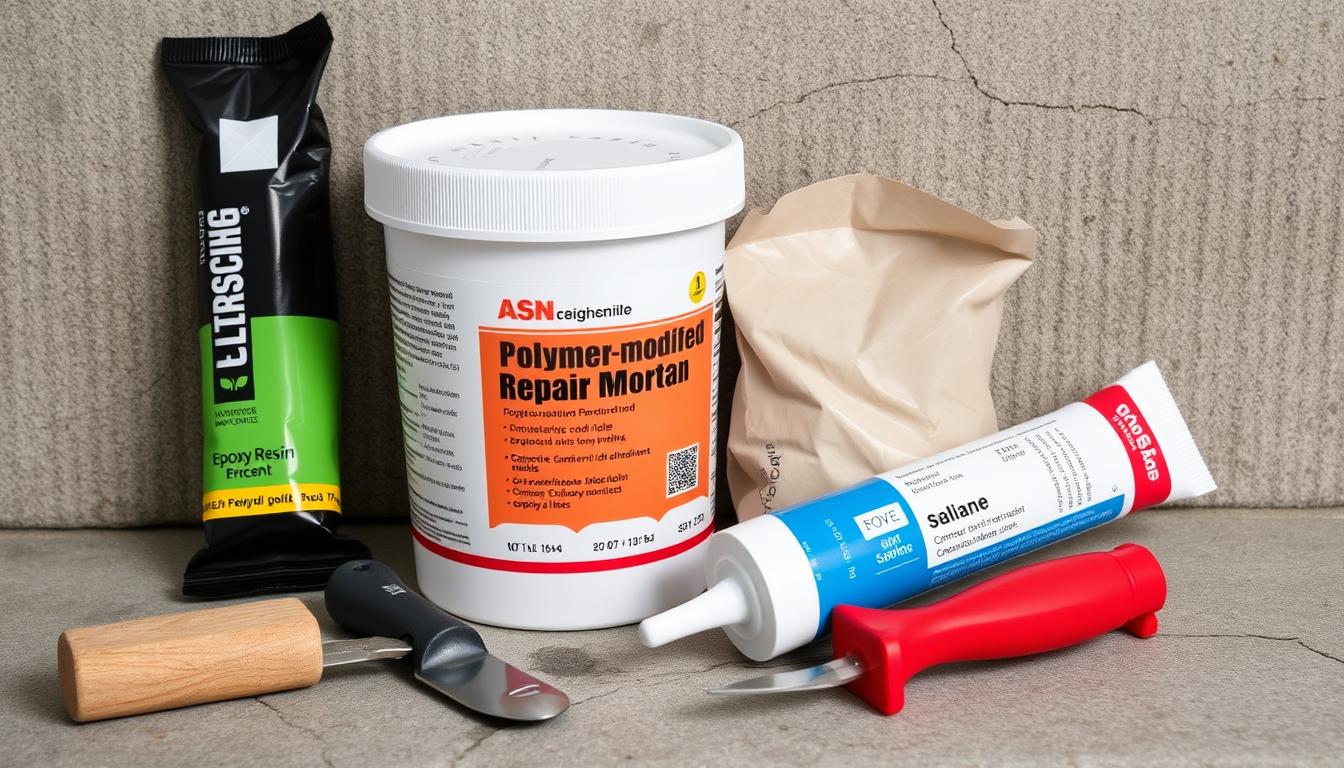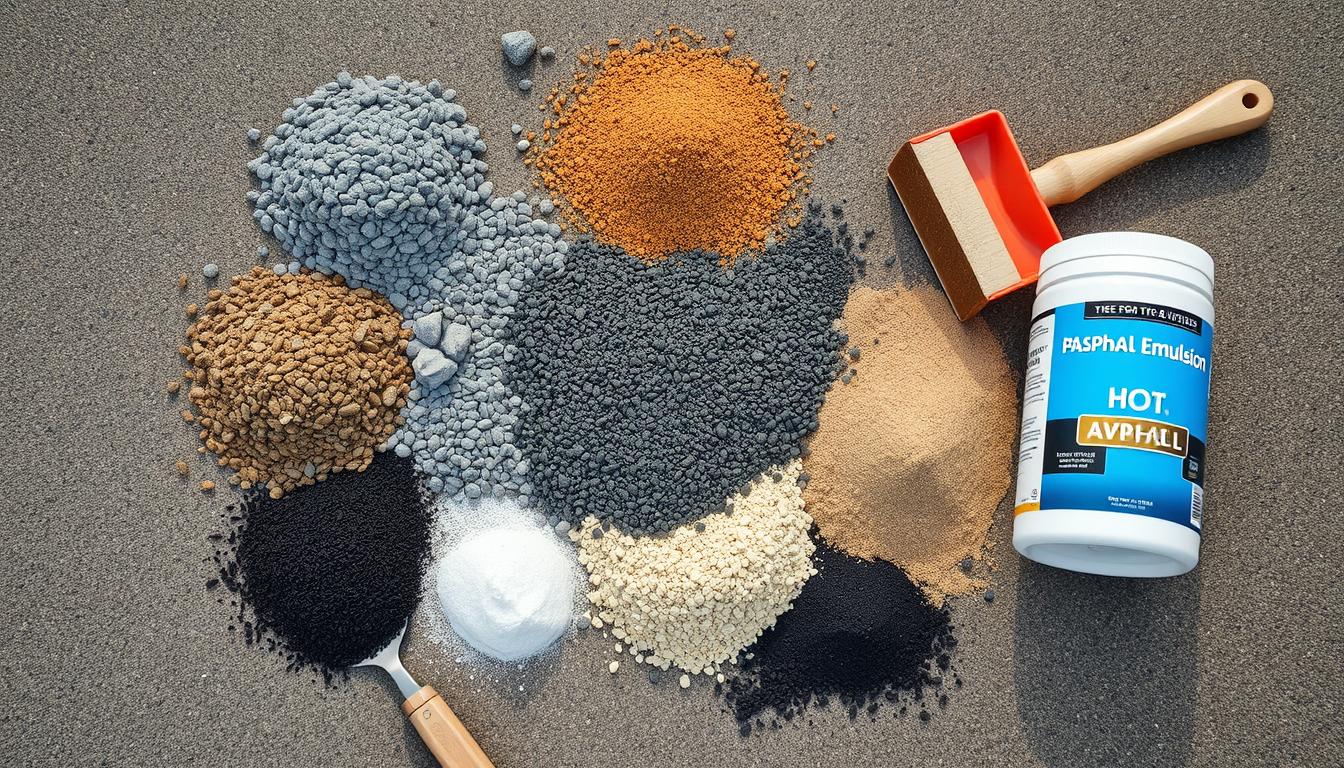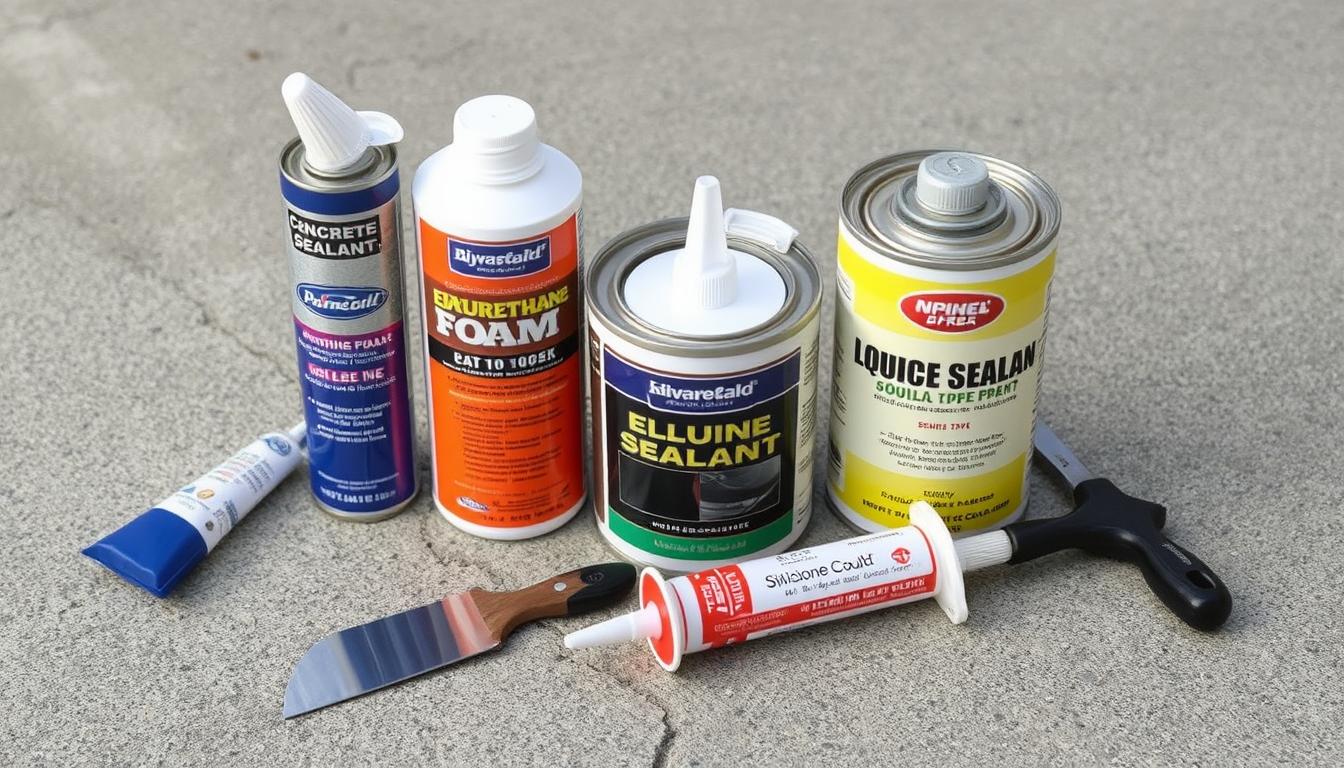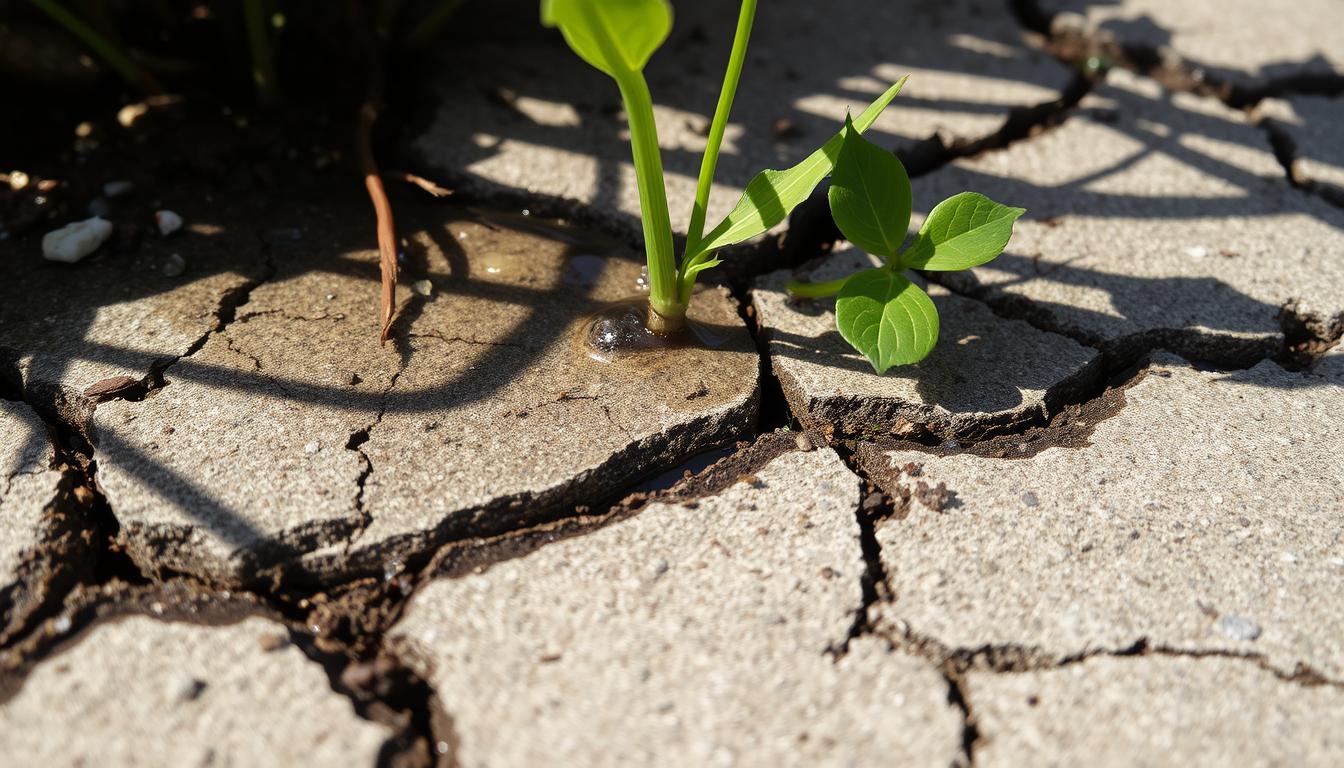Ever wondered what materials are used for concrete crack filling? Or why some repairs last years while others fail quickly? The choice of materials is key. Knowing the different types of concrete crack repair materials helps both homeowners and professionals make better choices. This is important for fixing cracks in driveways, sidewalks, and patios.
With many fillers made for different types of cracks, picking the right one is critical. It helps keep your concrete surfaces strong and lasting longer. Let’s look at the various materials available and why they’re important for fixing cracks well.
Key Takeaways
- Cracks under 1/4-inch wide are typically easy to repair with flexible fillers.
- Wider cracks may require backer rods or additional materials to ensure effective filling.
- Choosing the right material can prevent long-term structural damage and costly repairs.
- Different types of fillers are specially made for different crack sizes and types.
- Proper maintenance is vital, as many fillers may need to be replaced periodically to maintain effectiveness.
Understanding Concrete Cracks
Concrete cracks can harm both looks and strength. Knowing the types of cracks and why they happen is key. This knowledge helps pick the right materials for fixing cracks, making the concrete last longer.
Types of Concrete Cracks
There are mainly two types of concrete cracks: structural and non-structural. Structural cracks happen from too much weight or not enough support. They are wider than ⅛ inch and can be dangerous. Non-structural cracks are just ugly but don’t hurt the structure. They include crazing, crusting, and hairline cracks.
Each type needs its own fix, using the right concrete crack filling products.
Causes of Concrete Cracks
Cracks in concrete come from many things, like weather and the concrete itself. Freeze-thaw cycles can make the ground expand, causing cracks. Moisture can also get in and damage the rebar, leading to more cracks.
Knowing why cracks happen helps choose the best materials for fixing them. This ensures the repair works well and lasts a long time.
Overview of Crack Filling Materials
Choosing the right materials for fixing concrete cracks is key to making repairs last longer. There are many options for concrete crack sealants to fit different needs. Knowing these options helps not only in sealing cracks but also in stopping them from getting worse.
Common Materials for Filling Cracks
Asphalt-based fillers are a top choice for repairing concrete cracks. They work well for regular upkeep by sealing off moisture and stopping damage. Epoxy products, like Rust-Oleum’s 100-percent epoxy concrete repair patch, dry fast. This product dries in 8 hours and fills cracks or holes up to 0.5 inches deep.
For smaller cracks, Sikaflex Pro Self-Leveling Sealant is perfect. It’s made for cracks between 0.25 inches and 1.5 inches wide. It dries in 1 to 2 hours.
Specialty Products for Different Needs
Specialty products are for specific repair needs, like flexible sealants for moving cracks. DAP Liquid Concrete Patch is versatile and dries in 30 to 45 minutes. It covers about 90 linear feet.
For deep cracks, Sika’s acrylic-based patch needs multiple layers. Each layer takes 24 hours to dry. The RadonSeal foundation kit is great for foundation repairs. It fills cracks up to 0.5 inches thick and covers 10 feet of cracks in 24 hours. Picking the right sealant helps fix immediate problems and keeps concrete structures strong over time.
Asphalt-Based Repair Products
Asphalt-based repair products are popular for fixing cracks. They are flexible and water-resistant, making them great for many surfaces. They also help pavements last longer, which is why people choose them.
Characteristics of Asphalt-Based Fillers
Asphalt-based fillers have a lot of rubber, which makes them stretchy. This helps them stay flexible even in cold weather. They can fix up to 200 feet of cracks, lasting up to 10 years if applied right.
When to Use Asphalt-Based Crack Fillers
Use asphalt-based fillers for surface-level cracks in asphalt. They dry fast, making roads and driveways ready for use in 10 to 30 minutes. Fixing cracks early saves money and makes pavements last longer. They work well with special machines, making the repair process easier.
Epoxy and Polyurethane Solutions
Epoxy and polyurethane are great for fixing concrete cracks. Each has special qualities that fit different repair needs. Knowing their strengths helps pick the best one for the job.
Advantages of Epoxy for Concrete Repairs
Epoxy is known for its strong bond and water resistance. It’s perfect for filling deep cracks, keeping the repair strong over time. When applied right, epoxy forms a lasting seal against weather damage.
It’s important to follow the manufacturer’s instructions for the best results. This ensures the repair lasts as long as possible.
Polyurethane vs. Epoxy: Which to Choose?
Polyurethane is great for its flexibility. It’s perfect for areas that move, like with natural expansion and contraction. Choosing between polyurethane and epoxy depends on the project’s needs.
If you need a strong bond, epoxy is the way to go. But for areas that move, polyurethane is a better choice. It balances durability with flexibility.
Silicone Sealants for Flexibility
Silicone sealants are great for fixing concrete cracks because they are flexible and weatherproof. They work well for different crack sizes, helping concrete last longer. With the right care, they can last ten years or more, making them a smart choice for any concrete job.
Benefits of Using Silicone for Crack Filling
Silicone sealants stretch and shrink with temperature changes. This is great for outdoor use where weather can cause cracks to move. GE’s silicone concrete sealant is 100% waterproof and ready for water in just 30 minutes. It fully cures in 24 hours after use.
For best results, apply when the surface is above 32 degrees Fahrenheit, ideally around 70 degrees. These sealants fix cracks from tiny to up to 3 inches wide.
Application Tips for Silicone Sealants
For the best results, make sure the surface is clean and dry before applying. Fresh sealant should cure for at least a few days, but it’s safe to walk on soon after. Curing times vary by product, but following the instructions ensures they last and perform well.
Grout and Mortar for Structural Repairs
Effective structural repairs need a good understanding of the materials used. Grout and mortar are key in fixing bigger issues in concrete. They are important for filling gaps and keeping load-bearing areas strong. Knowing how to use grout and mortar is vital for fixing things right.
The Role of Grout in Concrete Crack Repair
Grout fills big holes and keeps concrete structures stable. It stops concrete from moving too much, which is important for keeping things strong. There are different types of grout, like Portland cement and epoxy, for different repair jobs. For example, SikaGrout® 4316 works well in many temperatures and is strong.
Choosing the Right Mortar Mix
Choosing the right mortar mix is key for repairs. The right mix gives the needed strength and lasts long in important areas. Sika has many mortar products, like SikaEmaco® S 466, which is a special concrete for repairs. These products not only fix the problem but also last against tough weather.
How to Select the Right Material
Choosing the right material for concrete repair is important. You need to think about the type of cracks, their size, and the environment. Also, your budget and how long you want the repairs to last are key.
Factors to Consider
When picking a repair option, the size of the cracks matters a lot. For example, Sikaflex Pro Self-Leveling Sealant is great for cracks up to 1.5 inches wide. You also need to think about the environment, as some materials work better in wet conditions.
Deeper cracks require special care. Some products need to be applied in layers to fix them properly.
Cost vs. Longevity: Making the Right Choice
Cost and longevity are both important when choosing materials. DAP latex-based crack filler is cheap but only good for small cracks. It dries fast but might not last long.
Rust-Oleum’s epoxy concrete repair patch is more expensive but lasts longer. It dries in eight hours under the right conditions. Spending more on quality materials can save money in the long run. It’s about finding a balance between cost and durability.
The Importance of Professional Assistance
Fixing concrete cracks needs skill and the right stuff. Getting help from pros like HT Paving and Seal Coating Services makes repairs better. They check the surface first to fix all problems.
Benefits of Hiring HT Paving and Seal Coating Services
HT Paving and Seal Coating Services know a lot about concrete and asphalt. They know how the environment and structure affect these surfaces. They use top-notch methods and materials to fix cracks well.
With the right tools and materials, repairs last longer. This can add 5 to 10 years to a surface’s life. It also saves money on future repairs.
Our Expertise in Concrete and Asphalt Repair
HT Paving and Seal Coating Services can handle many types of cracks. They use special materials like rubberized asphalt for durability. Regular checks can make repairs last even longer.
Fixing cracks fast is key. Unfixed cracks can cost a lot more to fix later. Professional help ensures repairs are done right, lasting longer.
Ensuring Long-Lasting Results
To get durable and effective repairs for concrete cracks, following the best practices is key. Start by preparing the surface right. Clean the crack well with wire brushes and high-pressure washers. This is important because dirt can ruin the filler’s stickiness, affecting the repair’s durability.
Make sure to follow the manufacturer’s instructions for applying the filler. This way, you get the best results and longest life from the filler.
Best Practices for Crack Filling
Using top-notch materials is also essential for lasting repairs. Epoxy fillers, for instance, make the concrete stronger and look better because they come in different colors. They work great on small cracks, stopping them from getting bigger.
Apply the fillers in thin layers to avoid shrinkage and cracking as they dry. This helps keep the concrete looking good and lasting longer.
Don’t forget to check the repair regularly after it’s done. Watch for new cracks or old ones getting bigger. For big cracks, use flexible materials like polyurethane. By sticking to these practices, you can make your concrete last longer. This keeps your investment safe and makes sure everyone stays safe.
